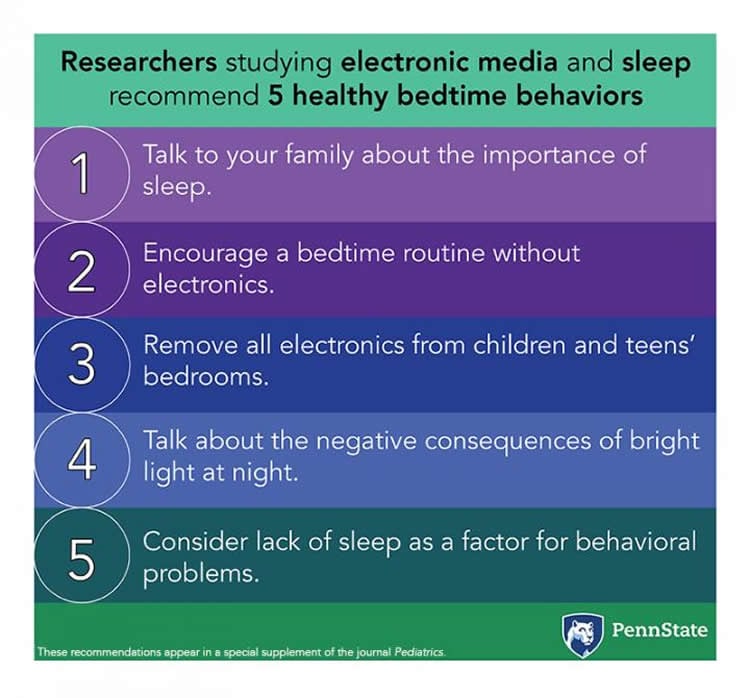Summary: A new study recommends different strategies, including removing digital devices before bedtime and embarking on calming activities to encourage healthy sleep in children and teens.
Source: Penn State.
Removing electronic media from the bedroom and encouraging a calming bedtime routine are among recommendations Penn State researchers outline in a recent manuscript on digital media and sleep in childhood and adolescence.
The manuscript appears in the first-ever special supplement on this topic in Pediatrics and is based on previous studies that suggest the use of digital devices before bedtime leads to insufficient sleep.
The recommendations, for clinicians and parents, are:
1. Make sleep a priority by talking with family members about the importance of sleep and healthy sleep expectations;
2. Encourage a bedtime routine that includes calming activities and avoids electronic media use;
3. Encourage families to remove all electronic devices from their child or teen’s bedroom, including TVs, video games, computers, tablets and cell phones;
4. Talk with family members about the negative consequences of bright light in the evening on sleep; and
5. If a child or adolescent is exhibiting mood or behavioral problems, consider insufficient sleep as a contributing factor.
“Recent reviews of scientific literature reveal that the vast majority of studies find evidence for an adverse association between screen-based media consumption and sleep health, primarily delayed bedtimes and reduced total sleep duration,” said Orfeu Buxton, associate professor of biobehavioral health at Penn State and an author on the manuscript.

The reasons behind this adverse association likely include time spent on screens replacing time spent sleeping; mental stimulation from media content; and the effects of light interrupting sleep cycles, according to the researchers.
Buxton and other researchers are further exploring this topic. They are working to understand if media use affects the timing and duration of sleep among children and adolescents; the role of parenting and family practices; the links between screen time and sleep quality and tiredness; and the influence of light on circadian physiology and sleep health among children and adolescents.
Other authors on the manuscript include Anne-Marie Chang, assistant professor of biobehavioral health at Penn State; Lauren Hale, from the Department of Family, Population and Preventative Medicine at Stony Brook Medicine in New York; Monique LeBourgeois and Lameese Akacem, from the Department of Integrative Physiology at the University of Colorado Boulder; and Hayley Montgomery-Downs, from the Department of Psychology at West Virginia University.
Source: Marjorie S. Miller – Penn State
Publisher: Organized by NeuroscienceNews.com.
Image Source: NeuroscienceNews.com image is credited to Joslyn Neiderer, Penn State.
Original Research: Full open access research for “Digital Media and Sleep in Childhood and Adolescence” by Monique K. LeBourgeois, Lauren Hale, Anne-Marie Chang, Lameese D. Akacem, Hawley E. Montgomery-Downs, and Orfeu M. Buxton in Pediatrics. Published online November 2017 doi:10.1542/peds.2016-1758J
[cbtabs][cbtab title=”MLA”]Penn State “Removing Digital Devices From Bedroom Improves Sleep For Kids and Teens.” NeuroscienceNews. NeuroscienceNews, 4 November 2017.
<https://neurosciencenews.com/sleep-development-digital-devices-7874/>.[/cbtab][cbtab title=”APA”]Penn State (2017, November 4). Removing Digital Devices From Bedroom Improves Sleep For Kids and Teens. NeuroscienceNews. Retrieved November 4, 2017 from https://neurosciencenews.com/sleep-development-digital-devices-7874/[/cbtab][cbtab title=”Chicago”]Penn State “Removing Digital Devices From Bedroom Improves Sleep For Kids and Teens.” https://neurosciencenews.com/sleep-development-digital-devices-7874/ (accessed November 4, 2017).[/cbtab][/cbtabs]
Abstract
Digital Media and Sleep in Childhood and Adolescence
Given the pervasive use of screen-based media and the high prevalence of insufficient sleep among American youth and teenagers, this brief report summarizes the literature on electronic media and sleep and provides research recommendations. Recent systematic reviews of the literature reveal that the vast majority of studies find an adverse association between screen-based media consumption and sleep health, primarily via delayed bedtimes and reduced total sleep duration. The underlying mechanisms of these associations likely include the following: (1) time displacement (ie, time spent on screens replaces time spent sleeping and other activities); (2) psychological stimulation based on media content; and (3) the effects of light emitted from devices on circadian timing, sleep physiology, and alertness. Much of our current understanding of these processes, however, is limited by cross-sectional, observational, and self-reported data. Further experimental and observational research is needed to elucidate how the digital revolution is altering sleep and circadian rhythms across development (infancy to adulthood) as pathways to poor health, learning, and safety outcomes (eg, obesity, depression, risk-taking).
“Digital Media and Sleep in Childhood and Adolescence” by Monique K. LeBourgeois, Lauren Hale, Anne-Marie Chang, Lameese D. Akacem, Hawley E. Montgomery-Downs, and Orfeu M. Buxton in Pediatrics. Published online November 2017 doi:10.1542/peds.2016-1758J






